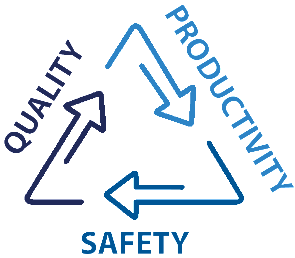What’s Your Safety Culture?

When it comes to safety, organizations of all kinds commonly strive for the ultimate goal - obtaining World-Class Safety Culture. So what does that mean? I won’t pretend to answer this question in one post, but I do hope to present some ideas and concepts for you to consider as you ponder that very question. Some prescribe to the idea that to have a World-Class Safety Culture the organization must recognize that safety is the most important thing you do. More important than production and/or quality. But is that how it should really work?
Now as a safety professional, I am not looking for the purest in our profession to send me hate mail, but really folks, think about it for a second. Without focusing on production you have limited output. This equates to less product, fewer customers, and lower sales. The same can be said for quality. Organizations that have poor quality have weak or non-existent sales. Clearly there has to be focus on both production and quality. But safety has to be just as important. I have found that organizations that truly do it best prescribe to the theory that safety, production, and quality must have equal focus. Each becomes part of the everyday routine. This sounds simple, but getting everyone aboard is not an easy task.
As Safety Management Consultants for a workers’ compensation insurance company, we are frequently asked to assess a policyholder’s safety culture. To see where they are on the continuum to world class safety, we typically look at policies and procedures, documented safety trainings, use of personal protective equipment (PPE) by workers, safety or tool box talks by supervisors, employee engagement in the safety program and many other quantifiable activities. If an organization is doing all of these activities does it mean they have a good safety culture? Maybe, maybe not is the best answer. No question they are doing a lot of things right, but have they reached the holy grail of safety culture? We have to dig in a little deeper to really answer the question.
Webster’s defines culture as “the set of shared attitudes, values, goals, and practices that characterizes an institution or organization.” (Merriam-Webster, 2019) World-Class Safety Culture does not equal activities. It is more about how safety is truly weaved throughout the organization in everything it does. That is the true goal - and it starts and ends with leadership. Ask any safety professional who has the opportunity to work in an organization where the President or CEO is committed to safety and they will tell you that commitment and engagement from the top trumps everything. In the recent Safety and Health Magazine article, “Safety Leadership: Workplace safety requires leaders invested in the long run” (Diaz, 2019) the author lists a series of questions senior leadership should ask when disaster strikes. A few of those are: What are we aiming for? Do we have a systematic approach to safety? What is the scope of our strategy? All are very pertinent questions for organizational leaders to ask themselves. But these questions should be asked every day, not only when there is a disaster.
Consider the following if you want to assess your organization’s safety culture. If one of your largest customers received a large order that was of poor quality, was damaged, or was incomplete, what would be the impact in your organization? What steps would be taken to identify not only what went wrong, but also what would be done immediately to keep it from happening again? Organizations that have a World-Class Safety Culture look at workplace safety incidents and near misses with the same level of intensity. They investigate the situation immediately, identify the root cause(s), and take immediate steps to assure it never happens again.
At the end of the day, it’s all about leadership commitment and urgency to keep safety, production, and quality all working as one cohesive practice, in every activity, each and every day. To find out more about safety culture and leadership, consider registering for MEMIC’s Integrating Safety with Business Goals workshop when offered throughout our service regions. Click here to see all of the currently offered workshops. You can also check out additional resources at MEMIC.com including our video lending library, the webinar archive, and the Resource Library in the Safety Director.
By Karl Siegfried

